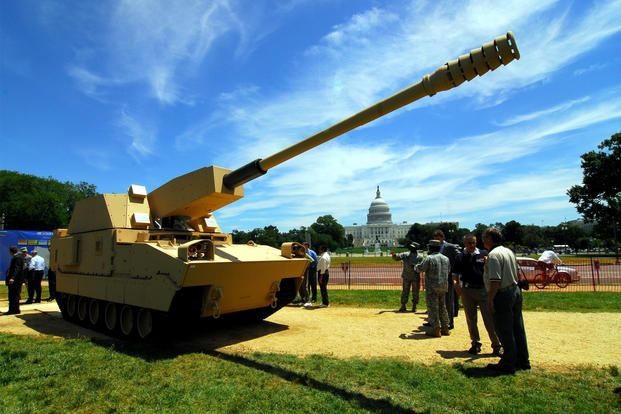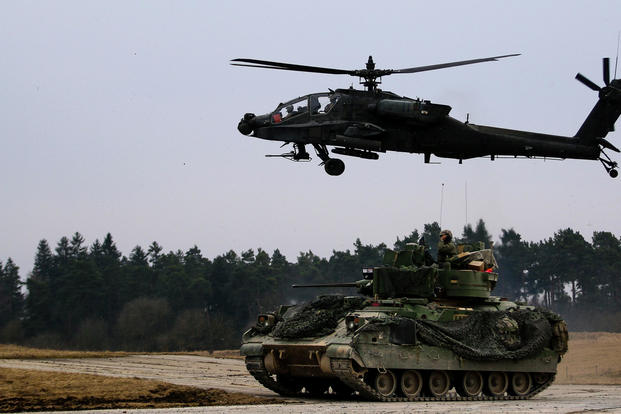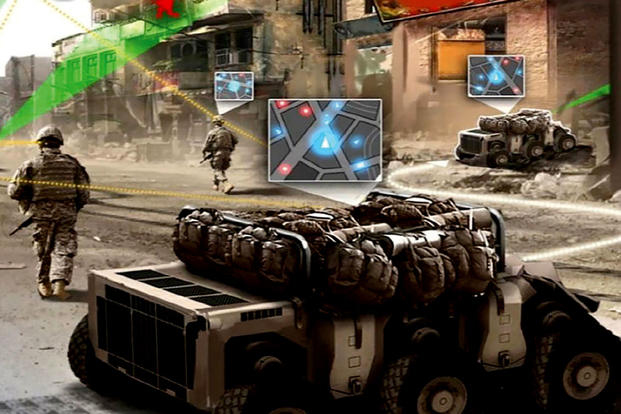The U.S. Army is locked on a path to replace its tanks, helicopters and other major combat systems -- a daunting venture in itself. But the true challenge for the service may be avoiding the minefield of mistakes that led to the multibillion-dollar demise of another leap-ahead plan, Future Combat Systems, less than a decade ago.
As with FCS, the Army is gambling big on advanced technologies, including some that don't exist yet in an operational form. It's a strategy that service leaders believe will place the Army ahead of its global competitors.
But military modernization experts watching the effort unfold warn that the service must guard against program flaws that have poisoned past dreams of a future force: poor salesmanship, weak leaders, priorities that shift over time, and the Army's true Achilles heel -- the enticement of leap-ahead technology.
Replacing the Big Five
Last October, the Army announced its bold plan with a somewhat ambiguous briefing describing how it will stand up a new modernization command as part of an acquisition reform strategy.
Since then, Army leaders have honed their vision into a message of need for the service to replace its Cold-War era, "big five" platforms in the coming decades to counter the sophisticated threat of Russia and China's futuristic weapons technologies.
The "big five" include the Abrams tank, Bradley fighting vehicle, Black Hawk helicopter, Apache gunship and Patriot air-defense missile system.
"[Today's Army is] the Army built to defeat the Soviets in the Fulda Gap," Army Secretary Mark Esper said during an address at the Association of the United States Army's 2018 winter meeting in late March.
"It's the Army that crushed the fourth-largest army in the world in the 1991 Gulf War and the one that raced from Kuwait to seize Baghdad in a few short weeks in 2003. It is also the Army we still have today ... and it's showing its age," he said. "And even if we never face Russia and China on the modern battlefield, we should expect to see their weapons -- equipment and tactics used by adversaries against us."
Esper and many other Army leaders spent the entire three days of the AUSA winter meeting explaining in detail how the service would create its force of the future. Teams of specialists from across the Army will work together like never before to cut years off the process of developing, selecting, testing and fielding advanced combat systems, officials said.
That's if all goes as planned.
How Future Combat Systems Failed
The Army's thirst for revolutionary, leap-ahead war machinery was most evident after it launched its Future Combat Systems program in 2003.
The ambitious effort attempted to create a future force of manned and unmanned vehicles, aerial drones, helicopters, robots, missiles and sensors, linking them together using a robust communications network.
Shifting requirements, cost overruns and program delays resulted in FCS reaching an astronomical projected cost ceiling of $160 billion before it was canceled in 2009.
One of the major flaws of FCS was that senior Army modernization officials gambled that many of the technologies needed for its combat vehicles and other platforms would mature by the time the service was ready to procure them.
"The whole concept of leap-ahead military systems is deeply flawed, and it is how you get a lot of these acquisition disasters," said Paul Scharre, a senior fellow at the Center for New American Security.
"These programs seemed to be based in science fiction more than reality. ... Your procurement system should be based on things that exist today," he said.
FCS was plagued by other flaws as well. At the time, the service often struggled to describe the program in clear language, according to Raymond DuBois, a former undersecretary of the Army during the FCS effort.
"One of FCS' political problems was if you asked six different general officers, 'Tell me what FCS means to you,' I got six different answers," DuBois, now a senior adviser at the Center for Strategic & International Studies, told Military.com.
DuBois said he remembers telling then-Secretary of the Army Francis Harvey, "There is not a single unified message as to A, what the program is and B, what you hope to accomplish."
The other problem with FCS was being "one huge program, which means one huge target from an appropriations and authorizations and congressional standpoint," DuBois said.
"It's too big, it's too complicated," he continued. "It's sort of like the F-35. It's so big, it's always under the microscope. It's always being criticized from one corner or another.”
Army Gen. Robert Abrams, son of the legendary Gen. Creighton Abrams Jr., who spearheaded the service's reform after the Vietnam War, bristles when the Army's new modernization effort is compared to FCS.
"Hey, look, this is not Future Combat Systems, let me be clear about it," Abrams, commander of the Army Forces Command, told an audience at AUSA 2018. "Nothing against anybody that had involvement in that program. That's not what this is."
Abrams made the assertion during a panel discussion about the Army's Next Generation Combat Vehicle.
"This is a focused effort and a teaming effort between an unmanned and a manned system, to deliver a capability that can close with and destroy the enemy with shock, mobility and firepower," he said.
Army Priorities
Unlike FCS, the service's new effort focuses on Army Chief of Staff Gen. Mark Milley's six modernization priorities.
These include:
- Long-Range Precision Fires -- new rockets and artillery capable of reaching far beyond today's systems to strike deep into enemy territory.
- Next Generation Combat Vehicle -- manned and potentially unmanned, robotic combat vehicles equipped with artificial intelligence to help crew members make decisions faster than ever before, as well as advanced armor and anti-missile defense systems.
- Future Vertical Lift -- a family of new airframes that consists of the advanced unmanned aerial system, future attack reconnaissance aircraft and long-range assault helicopter.
- Network -- a mobile communications network that's robust enough to withstand cyber and electronic warfare attacks.
- Air and Missile Defense -- a collection of advanced air-defense systems designed for the growing likelihood that ground units will no longer be able to rely on the Air Force to protect them from enemy air attack.
- Soldier Lethality -- new individual and crew-served weapons, as well as other equipment, for infantry and other combat-arms squads that offer a 10X-improvement in effectiveness against enemy ground forces.
Special cross-functional teams made up of program developers, requirements experts, acquisition officials and soldiers from the operational force have been dedicated to each priority to simplify and cut years off the time it normally takes to field mature equipment, Army leaders maintain.
"It's really working very closely, bringing everyone together and getting rid of maybe the 59 GS13s and 14s and lieutenant colonels," Army Vice Chief of Staff Gen. James McConville said at AUSA 2018, referring to senior civilians in the service.
"Now it's very streamlined, it's right to the top. The secretary and the chief or the undersecretary and I are working very, very closely, so the people that are sitting around the room now are the four-star commanders and the acquisition executive and the CFT leaders," he said. "They get very direct interaction with us, so they can quickly trade requirements …. 'Hey, you said 48 miles an hour. Will you take 47 and it will save you two years?' Yeah, in a second."
The Army should lock in these six modernization priorities if it wants to win congressional support over the long term, according to Bruce Hock, who served eight years on the staff of the Senate Armed Services Committee, working on Army and Marine Corps programs and acquisition policy.
And the Army needs to avoid referring to these priorities as the "chief's priorities," he said.
"We all need to be on the same page with the chief, but frankly, they are the Army's priorities," Hock said. "When I was on the Hill, the Navy and the Air Force would come over, and they would talk about their priorities. And those priorities didn't change from [chief of naval operations] to CNO or from chief of staff of the Air Force to chief of staff of the Air Force.
"And I know it's easier for them [because they] have big platforms that focus on big things," he added. "But when the Army went over to the Hill, it seemed like as soon as the chief changed, the Army's priorities changed, and I think that sends a mixed message."
The Promise of Futures Command
This summer, the Army is scheduled to stand up a new Futures Command, a four-star general headquarters that will be located in a soon-to-be announced major city so the command group can build new partnerships with academia and industry to help nurture innovation, Army leaders say.
According to DuBois, a new organization will not guarantee success.
"The question is, just by creating the Futures Command, is that going to solve your problem? The answer is no," he said.
The Army will need to select a strong leader for Futures Command, one who understands the "power of personality," DuBois said.
"When you have 535 members on your board of directors -- 100 senators and 435 members of the House -- you've got to be clever enough, not just with your authorizers but certainly with your appropriators as well as the leadership, so when you ask for billions of dollars and you have this hangover -- in the Army's case of FCS -- you better be really articulate and compelling," he said.
The leader of Futures Command will also need the authority to resist pressure to change program requirements, DuBois said.
"The other decision problem that the Army -- and the Navy and Air Force, quite frankly -- has always had is, you will get into a developmental program and then somebody says, 'Well, that requirement that you thought up two years ago, we need to change it,' and of course that then creates a waterfall of cost increases that in some cases are enormous," he said.
"That shouldn't be allowed to happen. That is going to be a key responsibility, in my view, and that's why I want to see a four-star run the Futures Command because you are going to have to have that kind of clout to say no," DuBois said.
Robotic Combat Vehicles
Robotic vehicles are slated to play a significant role in the next generation of ground platforms.
Commanders will have the option of sending an unmanned combat vehicle to attack the enemy before committing soldiers in manned combat vehicles, Army officials said.
Officials at Fort Benning, Georgia, are planning to build technology demonstrators of the first Robotic Combat Vehicles by 2021.
"We have seen this incredible advancement in robotics in the past few years," said Scharre, from the Center for New American Security, who just published "Army of None: Autonomous Weapons and the Future of War."
"It would be insane to build an Army of the future that doesn't have robotic vehicles as a part of it," he said.
But Scharre argues that the Army should not make unmanned and manned versions of the same vehicle.
"Many of the advantages of robotics is, I can change the physics of the vehicle; I don't need to have a crew compartment," he said. "I don't need to have armor. Maybe I can build something that is cheap and is expendable."
One option the Army should consider is adapting its older vehicles, such as the Humvee fleet, into robotic vehicles, Scharre said.
"They are not really survivable enough to put people in them in future wars, but we can take those vehicles and just put new sensors and autonomy on them and use them as robotic teammates," he explained. "If you can make the case, the cost case that makes sense to buy new, OK. But it has to be a business case. We spend twice as much money in DoD to get like a 10 percent improvement in something.”
In Scharre's opinion, the Army's modernization effort should not be aimed at replacing all existing ground vehicles with new platforms.
"I will grant you that the Bradley is kind of an ungainly vehicle, and it would probably make sense to redesign a ground combat vehicle," he said.
"If I were to rack and stack Army modernization priorities, I would not focus on ground platforms at all," Scharre said. "Because the underlying technology to make a tank has not radically changed, so we could spend billions of dollars and come up with a tank that is marginally better than an existing Abrams."
Army generals do seem to be very aware of the past mistakes the service has made with modernization efforts, and not just with FCS.
Gen. Stephen Townsend, commander of Training and Doctrine Command, said the service has attempted to improve the way it equips individual soldiers and squads more than once over the past 27 years.
"Since 1990, there have been no fewer than three efforts that were undertaken by our Army a lot like this one, using almost exactly the same language -- Soldier as a System, Ground Combat Soldier System and something similar to that," he said during a panel discussion at AUSA on the Soldier Lethality priority.
"They used the same language we are using today; the goal was to achieve decisive overmatch at the soldier and small-unit level," he added. "Here is my point: Fifteen years from now, I hope my successor is not sitting here showing you another version of my slide, talking about the importance of this topic and why we haven't got it right yet."
-- Matthew Cox can be reached at matthew.cox@military.com.
















